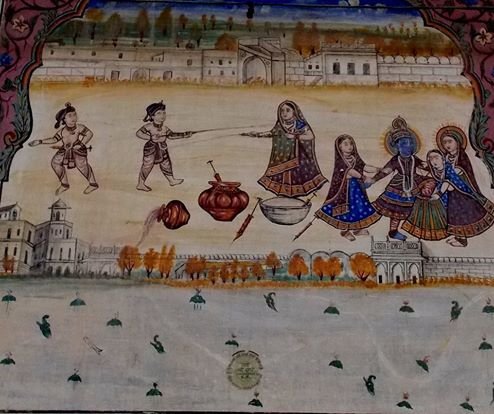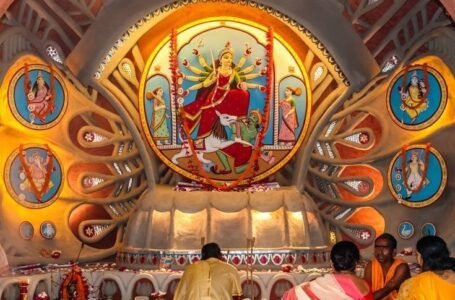The Endangered Art of Mathura Wall Paintings: A Journey Through Tradition, Spirituality, and Modernity

Mathura, often hailed as the birthplace of Lord Krishna and a spiritual hub of India, boasts a rich cultural heritage that has thrived for centuries. Among its many artistic gems, the intricate wall paintings that once adorned its homes, temples, and communal spaces hold a special place. These vibrant murals, depicting the life and legends of Krishna, not only celebrated the city’s spiritual essence but also showcased the artistic brilliance of its people. Sadly, with the relentless march of modernization, these exquisite artworks have suffered a steep decline, fading into obscurity.
This article takes a closer look at the history of Mathura’s wall paintings, their distinctive artistic features, the deep cultural and spiritual significance they hold, and the challenges threatening their survival. It also explores the steps that can be taken to revive this precious legacy before it is lost forever.
The tradition of wall painting in Mathura has deep roots, stretching back to the days when the city was a thriving cultural and artistic center during the Kushan and Gupta periods (around the 1st to 6th centuries CE). While Mathura is best known for its stunning sandstone sculptures and terracotta art, wall paintings gradually emerged as a powerful medium for creative expression, especially in the late medieval era.
It was during the 16th and 17th centuries, under the influence of the Bhakti movement, that these paintings truly came into their own. Devotion to Lord Krishna, Mathura’s beloved deity, found vibrant expression in colorful and intricate murals that adorned temples and homes alike. Drawing inspiration from the Puranas, epic tales, and local folklore, artists brought Krishna’s story to life with unmatched passion. Scenes from the Bhagavata Purana—like Krishna’s mischievous childhood in Gokul, his eternal love for Radha, and his heroic exploits in Vrindavan—became central themes, captivating the hearts of all who beheld them.
The wall paintings of Mathura are a beautiful blend of technical skill, vibrant colors, and deeply spiritual storytelling. Several features make this art form stand out:
- Subject Matter:
- Krishna’s Life: At the heart of Mathura’s wall paintings are vivid depictions of Krishna’s leelas (divine pastimes). Iconic scenes like the Ras Leela, Govardhan Puja, and the lush forests of Vrindavan often take center stage.
- Mythological Themes: While Krishna remains the focal point, other deities such as Radha, Ganesha, and Shiva also appear, reflecting the rich, syncretic spirituality of the region.
- Daily Life: Some murals portray the everyday lives of Mathura’s residents, seamlessly blending the sacred with the mundane.
- Artistic Techniques:
- Natural Pigments: Artists relied on pigments sourced from minerals, plants, and stones, which gave the murals their earthy yet striking hues. Shades like indigo, ochre, green, and red were especially prominent.
- Distinctive Style: The art style married folk traditions with classical influences. Figures were often elongated, their eyes expressive, and their postures fluid and graceful.
- Symbolic Motifs: Elements like lotus flowers, peacocks, and cows frequently appeared, symbolizing purity, divinity, and the pastoral charm of Krishna’s tales.
- Spatial Arrangement:
The murals were thoughtfully designed to complement architectural spaces. Larger, dramatic compositions adorned temple walls and ceilings, while smaller, more intimate scenes brought life to residential interiors.
Altogether, these paintings are a testament to the artists’ mastery, their deep devotion, and their ability to transform walls into visual stories that resonated with both the sacred and the everyday.
Mathura’s wall paintings are far more than mere decoration—they serve as a visual scripture, weaving together stories that have been cherished and passed down through generations. These murals are a profound connection to the community’s spiritual roots and cultural heritage.
- Community Identity:
The paintings played a vital role in fostering a sense of shared cultural identity among the people of Mathura. They were a reflection of the collective devotion to Krishna, acting as a unifying force, especially during festivals and religious gatherings, where the stories they depicted brought people closer together. - Spiritual Teaching:
In a time when oral traditions were the primary means of passing down knowledge, these murals served as powerful tools for spiritual education. They brought the teachings of the Bhagavad Gita and the Bhagavata Purana to life, making their messages accessible to people of all ages and literacy levels through vivid, unforgettable imagery. - Aesthetic Beauty:
Beyond their spiritual and cultural significance, the paintings also fulfilled the community’s love for beauty. They turned ordinary walls into extraordinary spaces, transforming homes and temples into places of inspiration and serenity, where art and spirituality seamlessly came together.
These murals were more than art—they were a living, breathing part of Mathura’s identity.
Despite their immense historical and cultural significance, Mathura’s wall paintings are now a rarity. Several factors have contributed to their decline:
- Modernization and Urbanization:
As Mathura continues to expand into a bustling urban center, many traditional homes and temples have been demolished to make way for modern structures. The murals, often created on lime-plastered walls, have been replaced by plain concrete surfaces, erasing a rich artistic legacy in the process. - Neglect and Lack of Awareness:
Unfortunately, the cultural value of these paintings is often overlooked by both local authorities and residents. Without proper care, many murals have been left to weather the elements, leading to their gradual deterioration and disappearance. - Economic Pressures:
For artisans who once dedicated their lives to this craft, the lack of support and patronage has been devastating. Many have been forced to abandon their work and turn to other professions to make ends meet, leaving the tradition without skilled practitioners. - The Rise of Technology:
With the availability of mass-produced alternatives like printed wallpapers and digital art, the demand for traditional wall paintings has dwindled. These modern options are cheaper and more accessible, pushing the age-old craft further into obscurity. - Cultural Shifts:
Younger generations are increasingly drawn to contemporary styles, viewing traditional murals as outdated. This shift in aesthetic preferences has further diminished interest in preserving or reviving Mathura’s unique artistic heritage.
Together, these factors paint a troubling picture for the future of this once-thriving art form, threatening to relegate it to the pages of history unless urgent steps are taken to protect it.
Preserving Mathura’s wall paintings is about more than just saving an art form—it’s about protecting a vital part of India’s cultural and spiritual legacy. Reviving this tradition requires a well-rounded and inclusive approach.
- Government Initiatives:
Organizations like the Archaeological Survey of India (ASI) and the Ministry of Culture should take the lead in documenting and restoring these murals systematically. Including Mathura’s wall paintings in heritage tourism circuits could also help draw attention, funding, and support for their preservation. - Community Involvement:
Educating local communities about the historical and cultural significance of these paintings is crucial. Workshops and exhibitions can help spark interest and pride, while offering incentives for preserving murals in homes and temples could encourage active participation from residents. - Supporting Artisans:
Traditional artists need financial assistance and skill-building opportunities to continue their craft. Collaborative projects with contemporary artists can also breathe new life into the tradition, blending innovation with heritage while keeping its essence intact. - Academic Research:
Universities and cultural institutions should prioritize in-depth studies on Mathura’s murals, publishing their findings to spark wider interest. Digital archives and virtual exhibitions could also ensure this art form is preserved and accessible to future generations. - Media and Awareness Campaigns:
The power of storytelling can’t be underestimated. Documentaries, books, and social media campaigns can spotlight both the beauty of Mathura’s murals and the challenges they face, bringing their plight to a global audience and inspiring collective action.
Saving Mathura’s wall paintings isn’t just about restoring faded colors on a wall—it’s about preserving the stories, devotion, and artistry of an entire culture for generations to come.
Mathura’s wall paintings are a testament to the city’s rich artistic and spiritual legacy. Their intricate designs and vibrant narratives offer a glimpse into the devotional fervor and aesthetic sensibilities of a bygone era. However, without concerted efforts to preserve and revive this art form, it risks being lost forever. The decline of these murals is not merely a loss for Mathura or Uttar Pradesh but for the entire world, as they represent a universal heritage of storytelling, spirituality, and artistic innovation. By recognizing their value and taking proactive steps to conserve them, we can ensure that future generations continue to be inspired by the timeless tales of Krishna and the artistry of Mathura’s master painters.


